Precalculus by Richard Wright
Precalculus by Richard Wright
…though he may stumble, he will not fall, for the Lord upholds him with his hand. Psalms 37:24 NIV
Summary: In this section, you will:
SDA NAD Content Standards (2018): PC.5.3
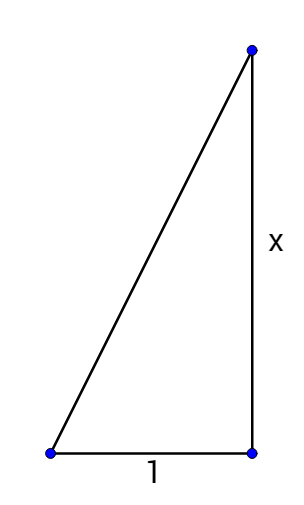
Right triangles such as the one in figure 1 can be used to simplify compositions of trigonometric functions such as sin(tan–1 x).
Lesson 1-09 stated that if f(x) and f–1(x) were inverses, then f(f–1(x)) = x and f–1(f(x)) = x. The same is true for trigonometric functions with an exception. The domain of the inverse functions must be applied.
If –1 ≤ x ≤ 1 and \(–\frac{π}{2}\) ≤ y ≤ \(\frac{π}{2}\), then sin(sin–1(x)) = x and sin–1(sin(y)) = y
If –1 ≤ x ≤ 1 and 0 ≤ y ≤ π, then cos(cos–1(x)) = x and cos–1(cos(y)) = y
If x is a real number and \(–\frac{π}{2}\) < y < \(\frac{π}{2}\), then tan(tan–1(x)) = x and tan–1(tan(y)) = y
Remember to be careful that the domain and range of the composition is maintained. Work through the composition from the inside out.
Evaluate a) \(\sin\left(\arcsin \frac{1}{2}\right)\), b) \(\cos\left(\cos^{–1} \frac{2π}{3}\right)\), c) tan(arctan (–10)).
Solution
Evaluate a) sin(sin–1(0.345)) and b) \(\cos\left(\cos^{–1} \left(–\frac{2}{3}\right)\right)\).
Answers
0.345; \(–\frac{2}{3}\)
Evaluate a) \(\arcsin\left(\sin \frac{π}{3}\right)\), b) \(\arccos\left(\cos \frac{5π}{4}\right)\), and c) tan–1(tan π).
Solution
\(\arcsin\left(\sin \frac{π}{3}\right)\): Work from the inside out. \(\sin \frac{π}{3} = \frac{\sqrt{3}}{2}\) so
\(\arcsin\left(\sin \frac{π}{3}\right)\)
\(= \arcsin \frac{\sqrt{3}}{2}\)
\(= \frac{π}{3}\)
\(\arccos\left(\cos \frac{5π}{4}\right)\): \(\cos \frac{5π}{4} = –\frac{\sqrt{2}}{2}\) so
\(\arccos\left(\cos \frac{5π}{4}\right)\)
\(= \arccos \left(–\frac{\sqrt{2}}{2}\right)\)
\(= \frac{3π}{4}\)
(Remember the range of arccos is 0 ≤ y ≤ π.)
tan–1(tan π): tan π = 0 so
tan–1(tan π)
= tan–1(0)
= 0
(Remember the range of tan–1 is \(–\frac{π}{2}\) ≤ y ≤ \(\frac{π}{2}\).)
Evaluate a) \(\arctan\left(\tan \frac{3π}{4}\right)\) and b) sin–1(sin(–0.354)).
Answers
\(–\frac{π}{4}\); –0.354
Compositions of trigonometric functions can also be solved using right triangles. Use the inner function to draw a right triangle, then use the triangle to evaluate the outer function.
Evaluate a) \(\cos\left(\arcsin \frac{3}{5}\right)\) and b) \(\tan\left(\cos^{–1} \left(–\frac{2}{3}\right)\right)\).
Solutions
Start with the inner function, \(\arcsin \frac{3}{5}\). \(\sin x = \frac{opposite}{hypotenuse}\), so draw a right triangle in quadrant 1 and label the acute angle by the origin. The opposite side is 3 and the hypotenuse is 5. See figure 2. Use the Pythagorean theorem to find the other side.
32 + b2 = 52
b = 4
Now evaluate the outer function, cos u.
\(\cos u = \frac{adj}{hyp}\)
\(\cos u = \frac{4}{5}\)
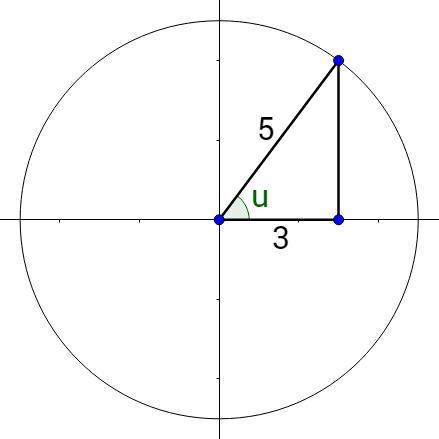
Start with the inner function, \(\cos^{–1} \left(–\frac{2}{3}\right)\) and draw a right triangle. Since the ratio of sides is negative, draw the triangle in the negative quadrant of the inverse trigonometric function. For cos–1 the negative quadrant is quadrant 2. Label the angle by the origin and the adjacent side –2 and hypotenuse 3. See figure 3. Use the Pythagorean theorem to find the other side.
(–2)2 + b2 = 32
\(b = \sqrt{5}\)
Now evaluate the outer function, tan u.
\(\tan u = \frac{opp}{adj}\)
\(\tan u = –\frac{\sqrt{5}}{2}\)
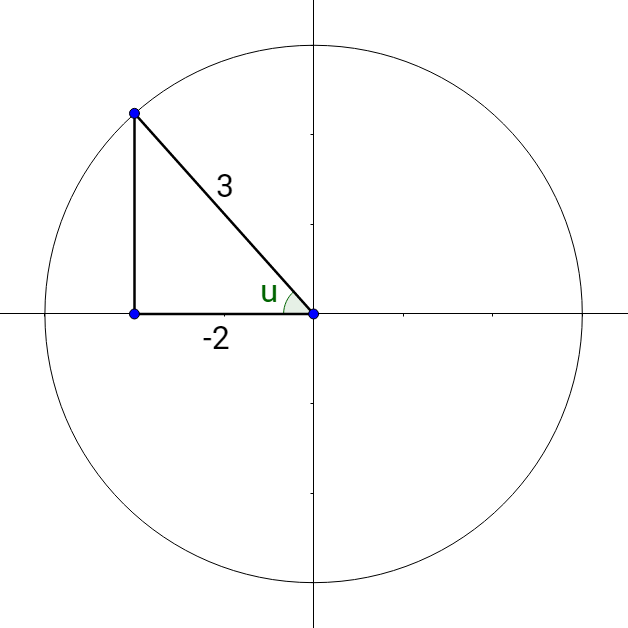
Evaluate \(\sin\left(\arctan \left(–\frac{12}{5}\right)\right)\).
Answer
\(–\frac{12}{13}\)
Evaluate a) \(\tan^{-1} \left(\cos \left(\frac{3π}{2}\right)\right)\) and b) \(\cos^{-1} \left(\sin \left(\frac{2π}{3} \right)\right)\).
Solutions
Start with the inner function, \(\cos \left(\frac{3π}{2}\right)\). This time the input is an angle, so sketch that on the unit circle. Since it is a quadrantal angle, find a point on the terminal side such as (0, −1). See figure 4.
$$ \cos u = x $$
$$ \cos\left(\frac{3π}{2}\right) = 0 $$
Now evaluate the outer function, inverse tangent.
$$ \tan^{-1} \frac{y}{x} = u $$
$$ \tan^{-1} \frac{0}{1} = 0 $$
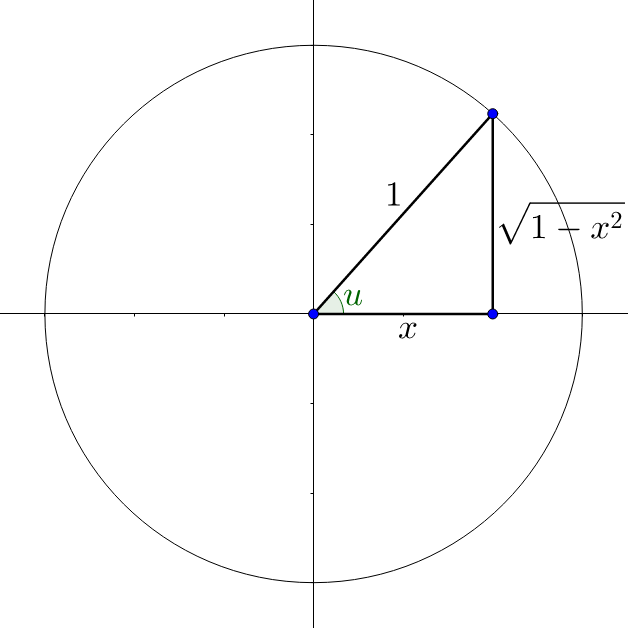
Start with the inner function, \(\sin \left(\frac{2π}{3}\right)\). This time the input is an angle, so sketch that on the unit circle. Make note of the coordinate of the terminal side, \(\left(-\frac{1}{2}, \frac{\sqrt{3}}{2}\right)\). See figure 5.
$$ \sin u = y $$
$$ \sin\left(\frac{2π}{3}\right) = \frac{\sqrt{3}}{2} $$
Now evaluate the outer function, inverse cosine.
$$ \cos^{-1} x = u $$
$$ \cos^{-1} \frac{\sqrt{3}}{2} = \frac{π}{6} $$
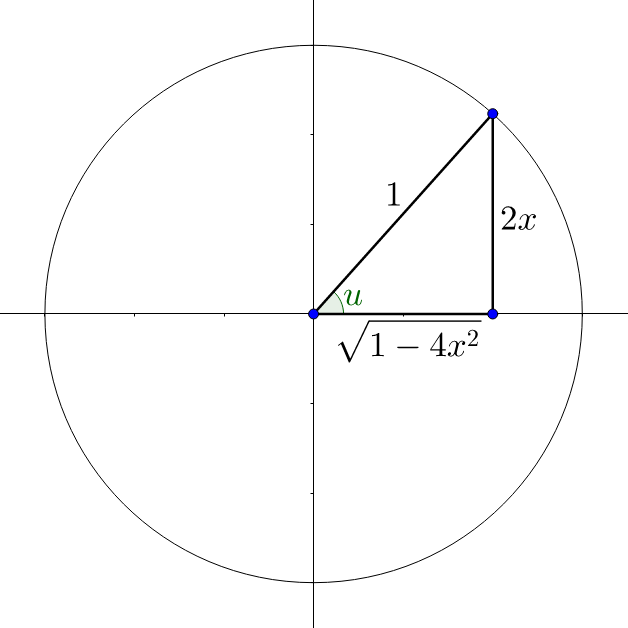
Evaluate \(\arccos \left(\sin \left(\frac{π}{4}\right)\right)\).
Answer
\(\frac{π}{4}\)
Rewrite as an algebraic expression a) sin(arccos(x)) and b) tan(sin–1(2x)).
Solutions
Draw a right triangle and label the sides. The ratio of the sides is \(x = \frac{x}{1}\). Since the inner function is \(\arccos\left(\frac{x}{1}\right)\), the adjacent side is x and the hypotenuse is 1. See figure 6. Use the Pythagorean theorem to find an expression for the third side.
x2 + b2 = 12
b2 = 1 – x2
\(b = \sqrt{1 – x^{2}}\)
Now evaluate the outer function, sine.
\(\sin u = \frac{opp}{hyp} = \frac{\sqrt{1 – x^{2}}}{1}\)
\(\sin u = \sqrt{1 – x^{2}}\)
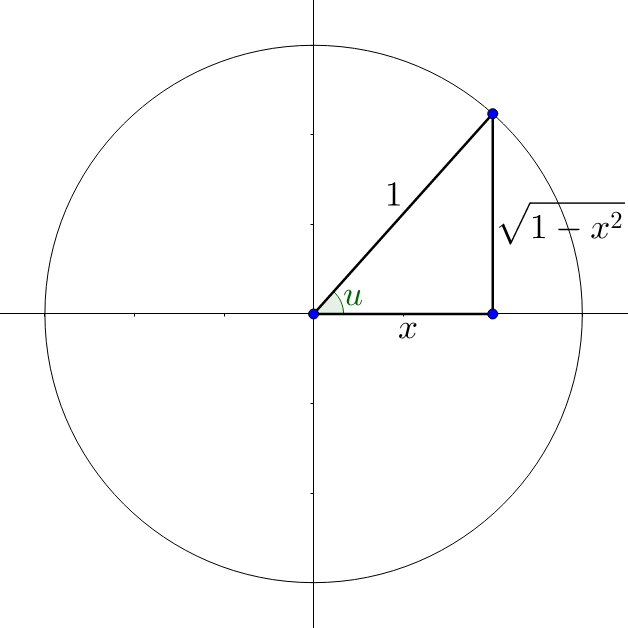
Draw a right triangle and label the sides. The ratio of the sides is \(2x = \frac{2x}{1}\). Since the inner function is \(\sin^{–1}\left(\frac{2x}{1}\right)\), the opposite side is 2x and the hypotenuse is 1. See figure 7. Use the Pythagorean theorem to find an expression for the third side.
a2 + (2x)2 = 12
a2 + 4x2 = 1
a2 = 1 – 4x2
\(a = \sqrt{1 – 4x^{2}}\)
Now evaluate the outer function, tangent.
\(\tan u = \frac{opp}{adj}\)
\(\tan u = \frac{2x}{\sqrt{1 – 4x^{2}}}\)
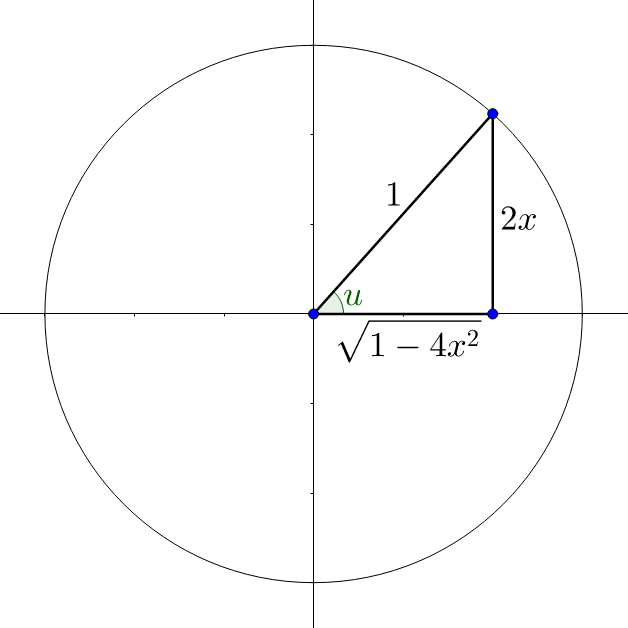
Rewrite as an algebraic expression: \(\cos\left(\arctan\left(\frac{x}{2}\right)\right)\).
Answer
\(\frac{2}{\sqrt{x^{2} + 4}}\)
If –1 ≤ x ≤ 1 and \(–\frac{π}{2}\) ≤ y ≤ \(\frac{π}{2}\), then sin(sin–1(x)) = x and sin–1(sin(y)) = y
If –1 ≤ x ≤ 1 and 0 ≤ y ≤ π, then cos(cos–1(x)) = x and cos–1(cos(y)) = y
If x is a real number and \(–\frac{π}{2}\) < y < \(\frac{π}{2}\), then tan(tan–1(x)) = x and tan–1(tan(y)) = y
Remember to be careful that the domain and range of the composition is maintained. Work through the composition from the inside out.
Helpful videos about this lesson.
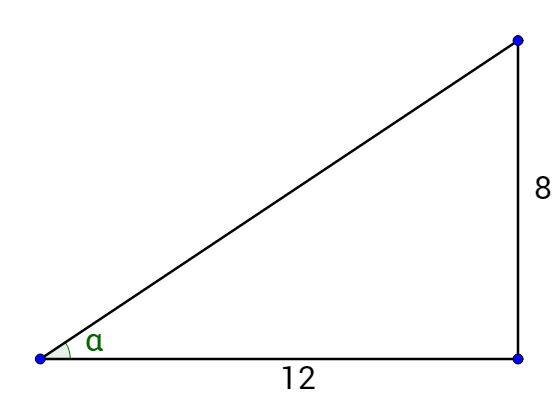
| \(\sin α = \frac{2\sqrt{13}}{13}\) | \(\cos α = \frac{3\sqrt{13}}{13}\) | \(\tan α = \frac{2}{3}\) |
| \(\csc α = \frac{\sqrt{13}}{2}\) | \(\sec α = \frac{\sqrt{13}}{3}\) | \(\cot α = \frac{3}{2}\) |